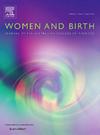Enablers and barriers to practice planned home birth for midwives in Spain: A qualitative study
IF 4.1
2区 医学
Q1 NURSING
引用次数: 0
Abstract
Problem
Planned home birth is a practice that remains uncommon in Spain, and research on midwives' perspectives regarding the facilitation of planned home births is scarce.
Background
The quality of care in planned home births assisted by midwives is increasingly improving. However, in Spain, the supported of planned home births remains a controversial topic and is a practice rarely undertaken by midwives.
Aim
The objective of this study was to describe the perceptions and views of midwives working in the clinical setting of the Spanish public healthcare system regarding the supported of planned home births.
Methods
A qualitative descriptive design, using thematic analysis was employed. Semi-structured interviews and focus group were conducted in 2024 with midwives working in the Spanish public health care setting (n = 14).
Findings
Three main themes were developed reflecting the patterns of meaning constructed through the data analysis: a) Perceived barriers and benefits of planned home birth with the subthemes “identifying obstacles to implementing planned home birth” and “motivations offered by the process”; b) The duality that accompanies home birth with the subthemes “in the shadows of the underground” and “demystifying the process”; c) The struggle for recognition with subthemes “integrating planned home birth into the public health system” and “promoting the path toward change”.
Discussion
Participants identified the factors and challenges that interfere with the facilitation of planned home births, emphasizing the need to develop strategies and initiatives with significant impact at governmental, professional, and social.
Conclusion
The data obtained provide an opportunity to reflect on the importance of including planned home birth support within the healthcare system.
西班牙助产士计划在家分娩的促进因素和障碍:一项定性研究
问题:在西班牙,计划在家分娩是一种不常见的做法,关于助产士促进计划在家分娩的观点的研究很少。背景:在助产士的协助下,计划在家分娩的护理质量日益提高。然而,在西班牙,支持计划的家庭分娩仍然是一个有争议的话题,助产士很少采取这种做法。目的:本研究的目的是描述在西班牙公共卫生系统的临床环境中工作的助产士对计划在家分娩的支持的看法和观点。方法采用定性描述设计,采用专题分析。2024年对在西班牙公共卫生保健机构工作的助产士进行了半结构化访谈和焦点小组(n = 14)。通过数据分析,研究人员开发了三个主题,反映了构建的意义模式:a)家庭计划生育的感知障碍和好处,分主题为“确定实施家庭计划生育的障碍”和“过程提供的动机”;b)伴随着家庭出生的二元性,其副主题是“在地下的阴影中”和“揭开过程的神秘面纱”;c)以“将家庭计划生育纳入公共卫生系统”和“促进变革之路”为分主题争取认可的斗争。讨论参与者确定了妨碍家庭计划生育的因素和挑战,强调需要制定在政府、专业和社会方面具有重大影响的战略和倡议。结论获得的数据提供了一个机会,以反映在医疗保健系统中包括计划生育支持的重要性。
本文章由计算机程序翻译,如有差异,请以英文原文为准。
求助全文
约1分钟内获得全文
求助全文
来源期刊

Women and Birth
NURSING-OBSTETRICS & GYNECOLOGY
CiteScore
7.20
自引率
13.20%
发文量
371
审稿时长
27 days
期刊介绍:
Women and Birth is the official journal of the Australian College of Midwives (ACM). It is a midwifery journal that publishes on all matters that affect women and birth, from pre-conceptual counselling, through pregnancy, birth, and the first six weeks postnatal. All papers accepted will draw from and contribute to the relevant contemporary research, policy and/or theoretical literature. We seek research papers, quality assurances papers (with ethical approval) discussion papers, clinical practice papers, case studies and original literature reviews.
Our women-centred focus is inclusive of the family, fetus and newborn, both well and sick, and covers both healthy and complex pregnancies and births. The journal seeks papers that take a woman-centred focus on maternity services, epidemiology, primary health care, reproductive psycho/physiology, midwifery practice, theory, research, education, management and leadership. We also seek relevant papers on maternal mental health and neonatal well-being, natural and complementary therapies, local, national and international policy, management, politics, economics and societal and cultural issues as they affect childbearing women and their families. Topics may include, where appropriate, neonatal care, child and family health, women’s health, related to pregnancy, birth and the postpartum, including lactation. Interprofessional papers relevant to midwifery are welcome. Articles are double blind peer-reviewed, primarily by experts in the field of the submitted work.
 求助内容:
求助内容: 应助结果提醒方式:
应助结果提醒方式:


